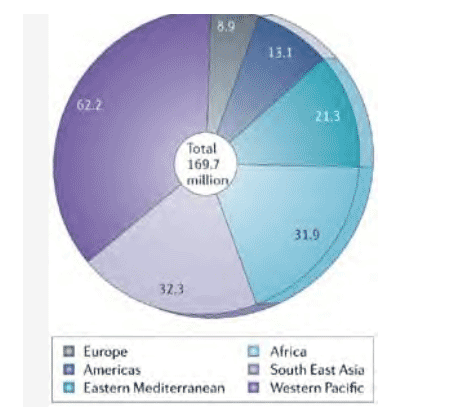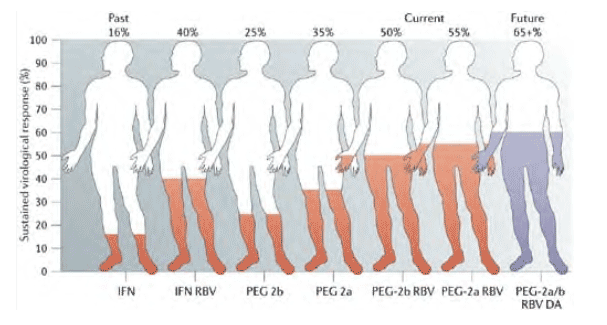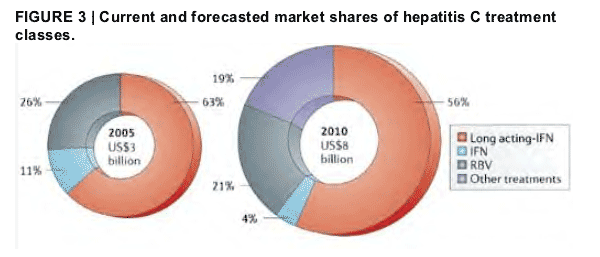| |
Hepatitis C virus therapies
|
| |
| |
Richard E. T. Smith1
http://www.nature.com
The hepatitis C virus (HCV) is believed to have infected approximately 170 million people worldwide (Fig. 1). Often referred to as the silent killer, patients can remain asymptomatic for decades before developing liver cirrhosis and/or hepatocellular carcinoma. Approximately 40-50% of liver transplants in the US are the result of HCV infection. Six major HCV genotypes (HCV1-6) have been identified, which vary in their geographic distribution and response to treatments.
The hepatitis C virus (HCV) is believed to have infected approximately 170 million people worldwide (Fig. 1). Often referred to as the silent killer, patients can remain asymptomatic for decades before developing liver cirrhosis and/or hepatocellular carcinoma. Approximately 40-50% of liver transplants in the US are the result of HCV infection. Six major HCV genotypes (HCV1-6) have been identified, which vary in their geographic distribution and response to treatments.
Although Europe and the Americas represent the major drug markets for HCV treatments, they comprise only a fraction of the worldwide patient population.

Standard of care is lacking
HCV patients currently receive a combination of pegylated interferon-alfa (PEG-IFN) - either 2a (Roche's Pegasys) or 2b (Schering-Plough's PEG-Intron) - and ribavirin (Rebetol (Schering-Plough), Copegus (Roche) and various generics). However, because of the once-a-week injections, many patients are unable to withstand the 24-week (for HCV2/3) or 48-week (for HCV1) course of treatment. Coupled with this, only around 50% of patients with the predominate genotype in the US and Europe, HCV1, achieve a sustained virological response (SVR) or 'cure' (Fig. 2). New approaches that improve response rates are therefore desperately needed.

Polymerase inhibitors
As with HIV drug development, the first direct antivirals to be developed for HCV were the nucleoside analogues that inhibit the non-structural protein 5B (NS5B) polymerase, an essential enzyme required for viral replication. Ribavirin is a weak inhibitor, but is very synergistic when combined with interferon. The problem of ribavirin-induced anaemia led to the development of a prodrug (Viramidine; Valeant) that seeks to circumvent this issue, as the prodrug is activated in the liver; however, efficacy results have been disappointing so far.
Newer nucleoside analogues are now in development, the most advanced being valopicitabine (NM283; Idenix/Novartis), which is currently in Phase II combination trials with PEG-IFN. Early results in both treatment-naive and treatment non-responder HCV1 patients proved encouraging; however, the higher incidence of gastrointestinal side effects in the high-dose arms led to the lowering of the valopicitabine dose in both trials. Phase III trials are expected to start in the first half of 2007, following the completion of ribavirin drug-drug interaction studies and further studies to investigate different doses and dosing schedules. Another nucleoside analogue in development is Roche's R1626. Interim results from a Phase I trial indicate that R1626 is effective and well tolerated, and Phase II combination trials with PEG-IFN and ribavirin are anticipated to start in the third quarter of 2006.
Non-nucleoside analogue inhibitors (NNI) that also target the HCV polymerase are in earlier stages of development. ViroPharma/Wyeth's HCV-796 is the most advanced member of this drug class. Interim Phase I data indicate that the drug is effective and well tolerated. The early development of resistance is not uncommon with this class, as is evident with NNIs for HIV, but like HIV these drugs will probably have to be used in combination with other therapies.
Protease inhibitors
The HCV NS3-4A serine protease has long been a desirable drug target for HCV; however, its shallow active binding site has made it difficult to design small-molecule inhibitors. Boehringer Ingelheim's BILN 2061 was the first to enter the clinic and although Phase I results were highly promising, further clinical development of this compound was halted because of cardiotoxicity in animals1.
Two other protease inhibitors are now in the clinic - Vertex's VX-950 and Schering-Plough's SCH-503034. VX-950 has shown significant potency in a 14-day Phase I trial in treatment-naive patients, either administered alone or in combination with PEG-IFN. Twelve out of twelve patients achieved undetectable levels of HCV RNA after 28 days of VX-950 and PEG-IFN and ribavirin treatment. Building on this success, the current Phase II trials are investigating 3 months of treatment with VX-950 in combination with PEG-IFN with or without ribavirin. Results are expected in late 2006.
The development of SCH-503034 has taken a different path, initially focusing on treatment non-responders. Phase I trials have indicated that the drug is not as potent as VX-950 at the doses tested so far, but higher doses are being tested in combination with PEG-Intron (Schering-Plough), with or without ribavirin in an ongoing 48-week Phase II trial. InterMune's ITMN-191 looks set to be the third protease inhibitor to enter the clinic (by year end).
Resistant variants have been identified to all these drugs in vitro and in vivo (except ITMN-191), though genotyping of patients in clinical trials has yet to show that selection of these variants (and/or others) leads to viral breakthrough. Longer trials will determine whether drug resistance is as valid a concern as it is in HIV.
Immunomodulators
Most experts agree that for the foreseeable future, HCV treatment regimens are likely to include an immunomodulator. Newer forms of IFN, such as Human Genome Sciences/Novartis' Albuferon (in Phase II) and Biolex/OctoPlus' Locteron (in Phase I), seek to reduce the frequency of dosing from once a week to once every 2 weeks and potentially once a month.
Newer approaches include the Toll-like receptor (TLR) agonists, a class of small molecules that specifically stimulate the innate immune system. In the clinic, TLR agonists include Coley's Actilon (CPG10101), a TLR9 agonist in Phase II, and Anadys' ANA-975, a TLR7 agonist in Phase I. Early results have shown signs of antiviral activity, although in the case of ANA-975 dosing was halted after preclinical data suggested prolonged dosing (13+ weeks) led to adverse events caused by intense immunological stimulation.
Future perspectives
It is evident that the way in which HCV is treated is about to change as new drugs edge towards the market. The protease inhibitors could have the greatest impact on treatment given their potential to shorten the duration of therapy, but many physicians remain cautious. SVR rates need to be improved, the holy grail being an all oral drug combination that pushes rates into the 80-90% range without the need for IFN injections. This goal remains some distance away, but in the meantime the current treatment market for HCV is likely to grow from approxUS$3 billion per year to more than $8 billion by 2010 (Fig. 3).

Market indicators
The market for the treatment of hepatitis C virus is set to rapidly expand in the coming years as new and more effective therapies enter the market (Table 1 and Fig. 3). We believe that only a fraction of patients diagnosed with a chronic HCV infection currently receive some form of treatment. Although the initial batch of antivirals are likely to be used in combination with the undesirable combination of PEG-IFN and ribavirin, we anticipate the potential for higher SVR rates than current treatments (Fig. 2), and shorter treatment durations will make these new treatment options more appealing to patients and help improve treatment rates.
|
|
| |
| |
|
|
|